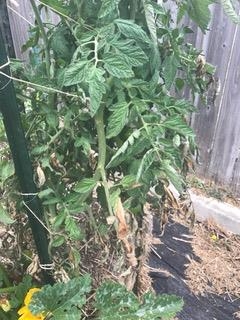Non-Problem Tomato Problem
Advice for the Home Gardener from the Help Desk of the
UC Master Gardener Program of Contra Costa County
Client: I noticed some leaves “browning and yellowing, maybe dying” on my Paul Robeson tomato (see photo), do you have any suggestions?

MGCC Help Desk Response: Thank you for contacting the UC Master Gardener Program Help Desk. It's been a busy season for the Help Desk, and we apologize for our delay in responding to your inquiry!
We understand that you are concerned about your Paul Robeson heirloom tomato plant's yellowing and dying leaves. The photo of your plant that you provided does not indicate a reason for concern for us. Overall, the plant looks healthy. It is not unusual for tomato plants to have browning leaves (especially lower leaves which may now be shaded from the sun) as we are headed toward the end of the growing season and have experienced some extremely hot weather recently.
We do have a few suggestions on how to extend your plant's production and growing season by giving it the best cultural care you can:
- You can lightly fertilize and be careful to consistently but not over water.
› After plants have set fruit you may want to fertilize with more nitrogen every 4 to 6 weeks.
› Water plants when the soil dries in the top 2-3”. Tomatoes need regular irrigation during the growing season - You may want to trim off the browning leaves as they won't be adding to the tomato's growth or production and could improve the plant's appearance.
- We notice that you have black weed cloth on the ground near your tomato plant. We suggest removing that cloth as it may be contributing to more heat in the soil. Instead use 2–3” of a wood or straw mulch around the plant instead of the cloth to block weed growth and keep the soil cooler. Be sure not to place the mulch against the plant stems.
We hope these suggestions help extend your tomato's production and growing season! Please let us know if you have any additional concerns or questions.
Help Desk of the UC Master Gardener Program of Contra Costa County (SLH)
Note: The UC Master Gardeners Program of Contra Costa's Help Desk is available year-round to answer your gardening questions. Except for a few holidays, we're open every week, Monday through Thursday for walk-ins from 9:00 am to Noon at 75 Santa Barbara Road, 2d Floor, Pleasant Hill, CA 94523. We can also be reached via telephone: (925)646-6586, email: ccmg@ucanr.edu, or on the web at http://ccmg.ucanr.edu/Ask_Us/ MGCC Blogs can be found at http://ccmg.ucanr.edu/HortCoCo/ You can also subscribe to the Blog (//ucanr.edu/blogs/CCMGBlog/).
Comments:
Again, thanks for reading and your comments.
CHEERS








Posted by Ron on August 14, 2017 at 5:49 AM